Racing
1998 Race Across America
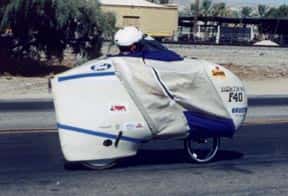
by Tim Brummer
For the first time ever, an HPV competed in the solo division of the Race Across AMerica (RAAM). Of course, it was a Lightning, and it was ridden by Bob Fourney. Bob Fourney is a three time RAAM winner; having won twice as a solo rider on an upright bike, and also on the four man Team Lightning in 1989, which set the current RAAM record of 5 days, 1 hour.
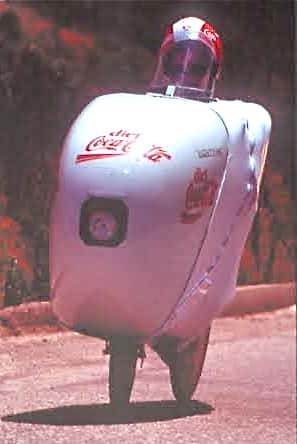
How this came about was another RAAM rider, Tim Skipper, wanted to do Team RAAM on Lightning HPVs. We contacted Bob Fourney, who agreed to be one of the riders. However, as time went on, Tim Skipper could not come up with the large amount of sponsorship money required to do Team RAAM. About this time, Bob said he would like to do RAAM solo on an HPV, and thought he could do a 7 day crossing! The current record on an upright bike is 8 days, 3 hours (which is still pretty good if you think about it).
So, we went around, and managed to get enough sponsorship from Loves County Stores, Recumbent Barn, Ford, and Gary Brustin to do solo RAAM. We also received component donations from Campagnolo, Hayes Brakes, and Continental tires. Since we wanted the bike to be as fast as possible, we spent months building a new bike just for this event.
R-84 frame, with Campagnolo 9-speed components, and a Hayes rear disc brake. The fairing used an F-40 nose cone, and a composite tail cone of new design. We used the X-2 shape as the starting point for this new tail cone. To complete the fairing, either a sailcloth or Spandex middle section could be quickly installed or removed in a minute or less. Since this was a significantly new design, it was christened the Lightning F-90.
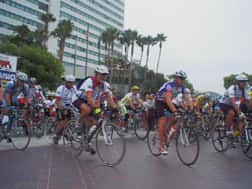
We also had a backup R-84 with F-40 fairing that Pete Penseyres had used in Paris-Brest-Paris in 1985, and an unfaired R-84 that we would use for climbing.
Since we knew it would be hot, we planned on putting ice-filled Camelbacks inside Bob’s Jersey. I tested this, along with the new bike, one week before the race in 95 degree weather, and it worked well. I was also very impressed with the disc brake during this test ride. On a 6% downhill, I continued to pedal, and only used the rear (disc) brake, but it simply would not fade! I had full braking power the whole way down. When I looked at it later, it was obviously heat discolored, but it still worked great!
The other crew members were P-38 owner Andreas Weigel, F-40 owner Greg DuVall, Bob’s uncle Gene Fourney, his friend Bobby, and physical therapist Marilyn Fogerty.

The race started from Irvine, California, on July 26th, with nice weather and temperatures of about 75 degrees. Later on, however, as the racers climbed over the mountains in Palm Springs, the temperatures heated up, and so did Bob. We gave him the ice-backs, and he was fine for a while.
Then, then, near Palm Springs, the van that Ford let us borrow picked up a nail in one tire. While myself and Andreas stopped at a tire store to fix that, the other van continued on with Bob. After a lot of hassle, we finally got the tire fixed, and caught up with Bob and the other van near the Salton Sea. When we got out to buy some ice, the heat was just incredible! According to the radio, it was 116 degrees. It was so hot, later on in the Imperial Valley, my shoes were sticking to the asphalt!
The other van, which was pacing behind Bob, was giving him ice-water in bottles every five to ten minutes, to keep him cool. It was working fairly well, since he was cruising along at over 25 mph! Once the sun went down, it cooled down some, although not much below 100.
That night, the course went along some really bumpy frontage roads, with pavement heaves about one inch high. You could really feel them in the pace van, but the F-90 suspension handled them with no problem. During the night, the crew members took turns trying to sleep in one of the beds we had in each van.
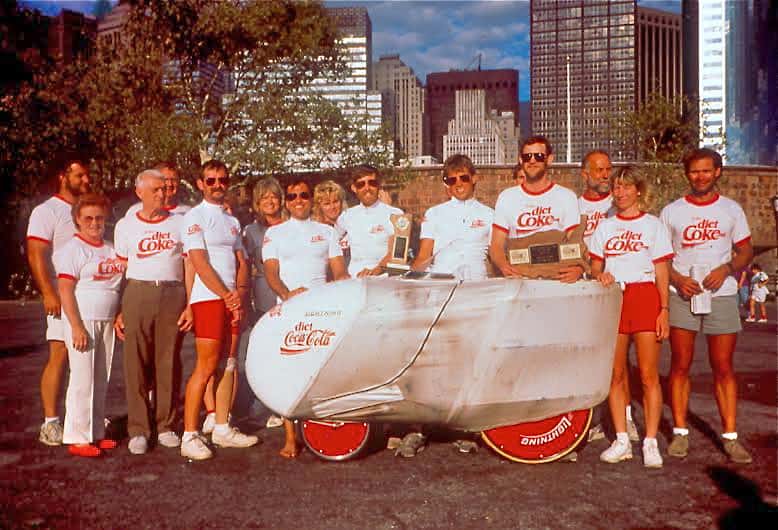
The next day, around sunrise, we were south of Phoenix. It was there we learned of a new rule that would totally change the race for Bob. The Arizona Highway Patrol would not allow the pace van to follow behind Bob. Instead, we had to go up the road, find a wide enough spot to get completely off the road, then wait for him to come by. After he went by, we would wait a while, then drive at about the speed limit and pass him. During the pass, we would try to slow down and give him another water bottle with ice water. The problem was, some of the turn-out places were far apart, and we couldn’t give Bob ice water often enough to keep him cooled down. It was at least as hot as the day before, and Bob was starting to slow down.
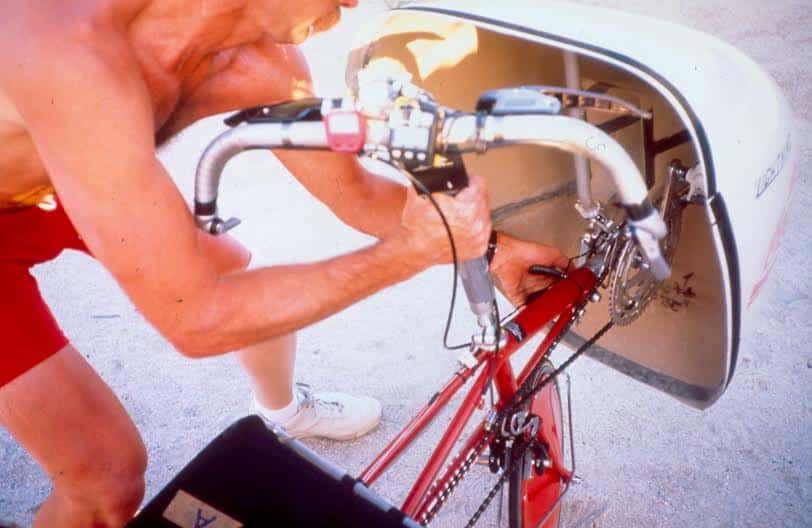
After the 3,000-foot climb into Superior, Arizona, Bob decided to stop at a motel and try to cool down, get some rest, and a massage. I had never been to Superior, and I can tell you, it has to be the closest thing to Hell on Earth. Not only was the temperature close to 120 degrees, but there was almost nothing growing on the steep, rocky mountains that surrounded the town.
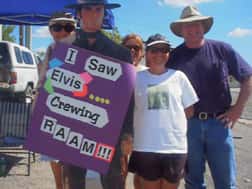
After a couple of hours, Bob took off again. When we reached the New Mexico border, it started to cool down. That night the weather was nice, but Bob couldn’t do much more than 15 mph on the flats. He had seriously overheated in Arizona, and his body had not recovered from it. We stopped at a motel in Lordsburg, New Mexico, and slept for four hours.
The next day, Bob took off at sunrise, and was doing well. Again, however, as the day heated up, he started to slow down. He got over the two 6,000-foot passes on the climbing R-84 fairly well, but could not maintain 20 mph on the flats.
Early in the third morning of the race, we stopped for four hours in Roswell, New Mexico. We were hoping that the somewhat cooler weather, and longer than normal rests stops, would help Bob recover from the heat stress. Unfortunately, it did not. He was not any faster the next morning, and at this pace, he would not break the 8 day, 3 hour record. The final straw was when Bob took a wrong turn, and rode 10 miles off course. This combined with seeing how next was Texas, where record temperatures were killing dozens of people, Bob decided the best thing for all involved was to stop.
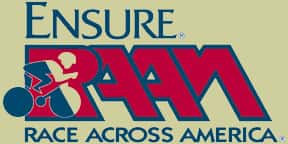
While we did not set a new cross country record, one positive aspect of our attempt was the reliability of the Lightning F-90. After over 1,000 miles, including about 200 miles of very rough roads, the only problems were 2 flat tires, and a rear derailleur bolt which vibrated loose.
Another was that we were quite fast through California, with a new solo record of 12 hours, 55 minutes for the 275 miles from Irvine Ca. to Yuma, AZ (on the border with California). Also, our times were faster than the lead solo upright rider, Gerry Tatrai, for most of our attempt.
In conclusion, while we did not achieve our goal of a new cross country record, this goal can be reached once we perfect better ways of keeping Bob cool, as the bike was demonstrated to be very fast and reliable. I might also add that Team Lightning was the only one to have the courage to attempt RAAM solo in an HPV, as there were no other HPV entries.